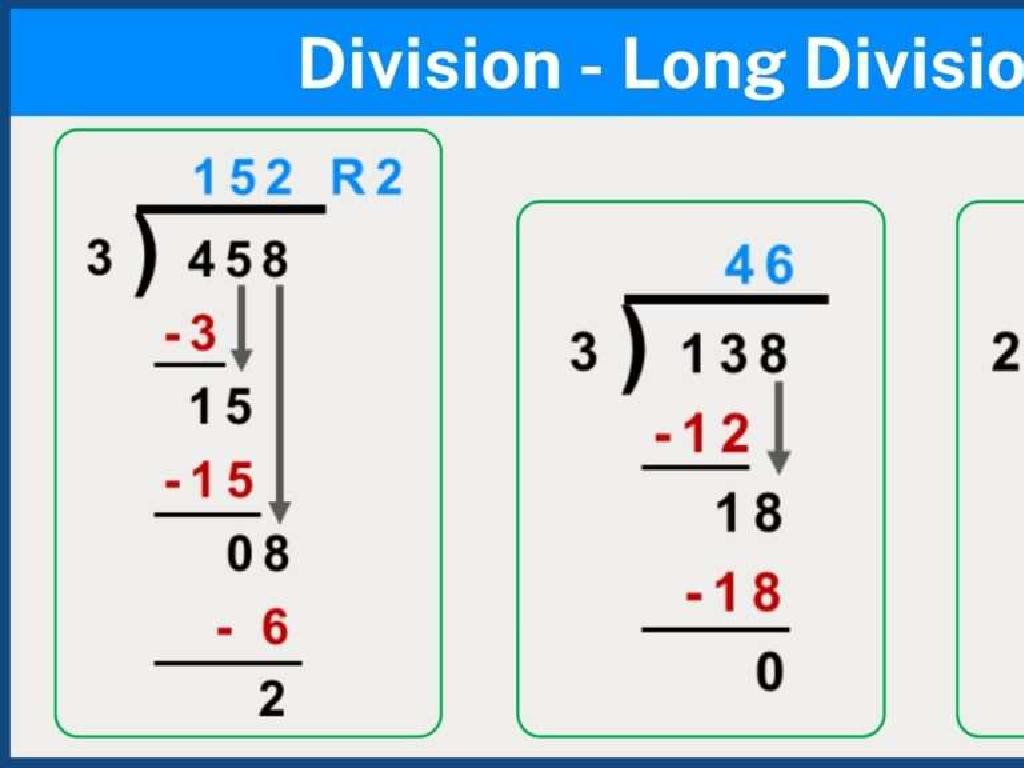Science Literacy: How Does The Nervous System Produce Phantom Pain?
Subject: Science
Grade: Eighth grade
Topic: Anatomy And Physiology
Please LOG IN to download the presentation. Access is available to registered users only.
View More Content
Exploring Phantom Pain in the Nervous System
– Overview of the nervous system
– The nervous system controls body functions and sensation.
– Science literacy in biology
– Understanding scientific concepts and their implications.
– What is phantom pain?
– Pain felt in a body part that’s no longer there.
– Investigating causes of phantom pain
– Brain’s response to missing sensory input from amputated limb.
|
This slide introduces the complex topic of phantom pain within the context of the nervous system. Begin by explaining the role of the nervous system in regulating bodily functions and sensations. Emphasize the importance of science literacy, particularly in biology, for understanding such phenomena. Define phantom pain as the sensation of pain in a limb or part of the body that has been amputated. Discuss how the brain can still send pain signals for the missing limb, leading to the experience of phantom pain. Encourage students to think critically about the implications of this phenomenon and how it affects individuals who experience it.
Exploring Phantom Pain
– Define Phantom Pain
– Pain felt in a body part that’s no longer there
– Common Phantom Pain experiences
– Sensations of itching, pressure, and temperature changes
– Real-life Phantom Pain examples
– Stories of amputees feeling pain where limbs once were
|
Phantom pain refers to pain or discomfort felt in an area of the body that has been amputated. While the exact cause is not fully understood, it’s believed to be related to mixed signals from the brain or spinal cord. Common experiences include feelings of itching, pressure, and changes in temperature or position in the absent limb. Real-life examples, such as amputees experiencing pain where their limb once was, can help students empathize and understand the complexity of the nervous system. Discuss the challenges faced by individuals with phantom pain and the importance of psychological support and treatment options.
The Nervous System and Phantom Pain
– Central vs. Peripheral Nervous System
– CNS includes the brain and spinal cord; PNS connects the rest of the body to CNS.
– Nerve signal transmission
– Nerves send electrical and chemical signals through neurons.
– Brain’s role in pain interpretation
– The brain processes signals from nerves as pain, even if there’s no injury.
– Understanding phantom pain
– Phantom pain occurs when the brain interprets signals from nerves that no longer reach a missing limb.
|
This slide introduces the nervous system’s structure and function, focusing on how it relates to the phenomenon of phantom pain. Begin with an overview of the Central Nervous System (CNS) and Peripheral Nervous System (PNS), highlighting their roles. Explain how nerves transmit signals to the brain, and how the brain interprets these signals as pain. Discuss the concept of phantom pain, where pain is felt in an absent limb, as a result of the brain interpreting ‘false’ signals from nerves that originally served the limb. Use diagrams to illustrate the CNS and PNS, and provide examples of phantom pain to help students visualize the concept. Encourage questions to ensure understanding.
Causes of Phantom Pain
– Amputation and phantom pain
– Loss of limb can lead to sensation of pain where limb used to be.
– Effects of nerve damage
– Damaged nerves may send false signals to the brain interpreted as pain.
– Psychological factors
– Emotional and psychological aspects can influence the experience of pain.
– Understanding pain perception
|
Phantom pain is a complex phenomenon often experienced after amputation of a limb, where the individual feels pain in the absent limb. This can be due to nerve damage where the nerves at the site of amputation continue to send pain signals to the brain, which mistakenly interprets them as coming from the missing limb. Psychological factors also play a role, as the brain’s expectation of pain or emotional stress can contribute to the sensation. It’s important to discuss how our nervous system interprets and perceives pain, even in the absence of physical causes. Encourage students to think about how the brain processes sensory information and the impact of psychological factors on our perception of pain.
Understanding Pain Reception
– How pain receptors function
– Pain receptors, or nociceptors, detect harmful stimuli and send signals.
– Journey of pain signals to the brain
– Signals travel via nerves to the spinal cord and then to the brain for interpretation.
– Physical vs. Phantom pain
– Physical pain arises from actual injury, while phantom pain occurs despite no physical harm.
|
This slide aims to explain the concept of pain reception in the human body. Begin with an explanation of pain receptors, known as nociceptors, which are responsible for detecting harmful stimuli and initiating the pain response. Discuss the pathway that pain signals follow from the site of injury through the nervous system to the brain, where they are recognized as pain. Highlight the distinction between physical pain, which is caused by real injury or damage to the body, and phantom pain, which is a sensation of pain without any physical cause, often experienced by amputees. This will set the stage for a deeper discussion on how the nervous system can produce phantom pain, which is a complex phenomenon not fully understood but believed to involve the brain’s interpretation of mixed signals from the nervous system.
Case Studies: Understanding Phantom Pain
– Explore documented phantom pain cases
– Cases show how amputees may feel pain where limbs once were
– Analyze treatments and effectiveness
– Look at various treatments like medication, therapy, and their success rates
– Examine personal coping strategies
– Personal stories reveal techniques like mirror therapy, mental exercises
– Discuss the impact on quality of life
– Understanding how phantom pain affects daily activities and mental health
|
This slide aims to delve into real-world examples of phantom pain to provide students with a comprehensive understanding of the condition. By examining documented cases, students can see the prevalence and variety of phantom pain experiences. Analyzing treatments will give insight into the medical and psychological approaches used to manage pain, including the success and limitations of each. Personal accounts are crucial for understanding the subjective experience and the coping strategies individuals develop, which may include mirror therapy, visualization, and other mental exercises. Discussing the impact on patients’ lives will help students empathize with those suffering from phantom pain and comprehend the broader implications on mental health and daily living. Encourage students to think critically about the material and consider how science is used to improve quality of life for those with this condition.
Managing Phantom Pain
– Explore medical treatments
– Medications and surgical options may alleviate pain
– Engage in physical therapy
– Exercises can help retrain the brain and reduce discomfort
– Seek psychological support
– Counseling can assist with emotional aspects of phantom pain
– Consider alternative therapies
– Acupuncture and meditation might offer additional relief
|
This slide aims to inform students about the various strategies for managing phantom pain, which is a sensation of pain in a part of the body that’s no longer there. Medical treatments can include medications to manage pain or even surgical interventions in some cases. Physical therapy is crucial as it involves exercises that can help the brain adapt to the loss of the limb and reduce the sensation of pain. Psychological support is also important, as phantom pain can be mentally challenging to cope with. Lastly, alternative therapies such as acupuncture or meditation can be explored for additional pain relief. Encourage students to think critically about how each treatment can help and to discuss the importance of a comprehensive approach to managing phantom pain.
Class Activity: Understanding Phantom Pain
– Discuss thoughts on phantom pain
– Role-play phantom pain scenarios
Simulate experiences of phantom pain to empathize with affected individuals.
– Write a reflection paragraph
Express your understanding of today’s lesson on phantom pain.
– Share learning with the class
|
This interactive class activity is designed to deepen students’ understanding of phantom pain through group discussion, role-play, and reflection. Begin by facilitating a group discussion where students share their initial thoughts on phantom pain. Follow this with a role-play activity to simulate scenarios where individuals experience phantom pain, helping students empathize and understand the impact of such a condition. Conclude the activity by asking students to write a short paragraph reflecting on what they learned about phantom pain, its causes, and effects. Encourage them to share their reflections with the class to foster a collaborative learning environment. Possible role-play scenarios include simulating daily challenges faced by individuals with phantom pain or portraying a doctor-patient consultation discussing phantom pain management.
Conclusion: Understanding Phantom Pain
– Recap: Nervous System & Phantom Pain
– Reviewed how nerves communicate pain without physical cause
– Science Literacy & Body Awareness
– Understanding our bodies promotes health and science education
– Open Floor for Questions
– Time to ask about today’s topic or any related queries
– Reflect on Today’s Learning
|
This slide wraps up the session on phantom pain and the nervous system. Begin by summarizing the key points discussed during the presentation, emphasizing how the nervous system can create the sensation of pain even in the absence of a limb, known as phantom pain. Highlight the importance of science literacy in empowering students to understand complex biological processes and how they relate to personal health. Open the floor for an interactive Q&A session, encouraging students to ask questions to clarify their understanding or to explore related topics. Use this opportunity to assess comprehension and to reinforce the day’s learning objectives. Conclude by reflecting on the importance of the day’s lesson and how it fits into the broader context of their science education.






